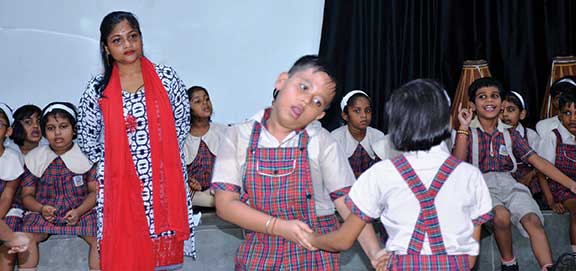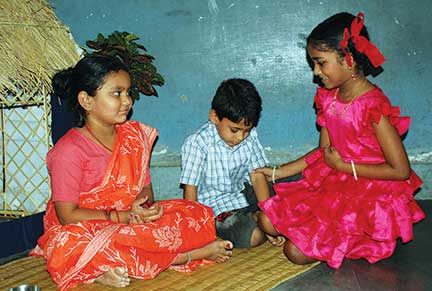Sanjhee Gianchandani
21st century educators have a lengthy checklist of aspects that they have to focus on in an ELT (English Language Teaching) classroom – engagement with the subject matter, social and emotional learning, hands-on learning, differentiation, catering to multiple learning preferences – and it goes on. Educators often find themselves in a quagmire of following existing strategies and innovating newer approaches for equitable dissemination of information. At this point, the simple methods of theatre, drama, and play can not only come to their rescue but also promote creative inquiry in unimaginable ways.
Retention of concepts and information in the minds of students is a major challenge faced by both educators and parents. Intertwined with this is the problem of making the content engaging enough for the learners. Many traditional teaching methods, such as reading from a textbook and answering questions, choral reading or listening to a recording of a text while following along, fail to fully engage a student’s attention. When a student’s attention is not engaged, his or her retention level is minimal. If a teacher is not commanding the students’ attention to the subject matter, the students will tend to lose focus and be off-task, resulting in further loss of knowledge and requiring more of the teacher’s time in classroom administration.
To help with this issue, a lot of ed-tech companies today have come up with video content, whiteboard explainer videos, and even bite-sized learning videos which can be utilized to introduce or revise concepts. But no one is talking about the importance of children using their own hands, bodies, and minds to capture the information into their systems. This is where the concepts of hands-on learning, experiential learning, and theatre come in.
Theatre can be defined as any form of performing arts including dancing, acting, singing, or storytelling. It is a broad term that encompasses numerous forms of expressing oneself in a dramatic or theatrical way. The word ‘drama’ is originally taken from the Greek term ‘drama’/’drao’, which also refers to ‘I do’ or action. This perfectly ties up with what we want students to be able to achieve by the end of a lesson – take charge and act!
The social development theory of Lev Vygotsky maintains that people develop skills from the culture by which they are surrounded; essentially, they learn without realizing they are learning. For example, if students are having fun performing a skit about how the digestive system works, they are learning while having a good time and may not actually realize that they are doing schoolwork and learning.
The idea of using theatre in classroom lessons is consistent with this theme of social development; the idea is that the students will be caught up and involved with the active learning style and will retain knowledge without actually trying to or realizing that they are learning complex concepts and ideas. This perspective is also consistent with Gardner’s multiple intelligences theory, which emphasizes using multiple mediums of learning for different types of learners.

Why theatre?
Philip Pullman, a famous children’s author states, “Children need art and stories and poems and music as much as they need love and food and fresh air and play.” Various research has found that live theatre is a powerful medium and that a majority of students demonstrate enjoyment and enthusiasm through watching educational theatre, are receptive and listening attentively, and can correctly identify the educational messages being portrayed. When we live in times where information is spoon-fed, gulped, and then regurgitated, theatre as a medium seeks to change this reality.
Using theatre to further the cause of education allows students to explore challenging social scenarios and vulnerable emotions in a safe and supportive environment. Theatrical performances can help them develop empathy for the experiences of others and explore the prescribed content from diverse perspectives. This is especially true for the stories and poems in the language curriculum. Be it Hindi, English, or the local language, it would most often have texts which can be performed in class. Moreover, students can also witness a range of possible strategies being played out in myriad situations and use critical thinking to evaluate the effectiveness of these strategies and apply them to their own lives.
In terms of 21st century skills, which have been the buzzword in the industry for some time now, theatre can also be used for teaching students self-regulation and social skills by physically demonstrating how these skills can be applied in different situations in their real lives. Theatre has also proven to help students develop positive tools for anger management and conflict resolution. The theatre in education experience also allows students to explore help-seeking options. Aside from dense and explicit learning, theatre has always been a window for a healthy emotional release, developing social awareness and independent thinking. Furthermore, as students collaboratively perform a skit or a play, they not only learn the qualities of teamwork and leadership but also those of giving and receiving constructive criticism from their peers and teachers.
How to use theatre in a classroom setting?
Many educators either shy away from using theatre in the classroom or are not fully aware of its powerful potential as a medium. You do not need extravagant lesson plans, stress-inducing heavy resources, or time-consuming activities to incorporate theatre in your day-to-day classroom. Here are some tips which you can use to seamlessly permeate drama in your lessons without much preparation or stress.

• Set the stage: Students look up to their teachers. If you incorporate just a little bit of drama in your everyday teaching methods, it will not only ease up your nerves but also give students the confidence to imitate you or use silly voices or gestures to act things out.
• Provide opportunities for low risk – or no audience performances: Put students in small groups or partnerships and slowly build their confidence. When students themselves ask to perform for the whole class, it means that they are ready. Never force a student to perform as it may flare up their stage anxiety in unimaginable ways. Instead, always offer students the opportunity to refuse to participate, but offer them another chance to try.
• Create a comfort zone: Stepping out of one’s comfort zone presents a dramatic possibility both of wonders and disasters. So, tread the zone with caution. Let them choose their groups and themes if possible. If they know that they’re in control, chances are that they’ll perform better. Also, it is pertinent to create a space where students can safely voice their opinions and interact with you as well as their peers.
• Explore themes: Different students are interested in different topics. Give students the freedom to choose topics and subjects if the drama is not on a singular text.
• Do drama warm-ups: Teachers might consider theatre and drama-based warm-ups (such as tongue twisters, one-word stories, drawing introductions, etc.) to help students relax and focus on the lesson ahead, or to simply set the context of learning. Warm-ups can be a fun and stimulating way of easing students into learning without jumping headfirst into the Pythagoras theorem or deciduous trees! Drama warm-ups are also useful in enhancing creative thinking skills which can be especially beneficial if your curriculum doesn’t make much room for creative subjects.
• Make monologues your best friend: Monologues are a great and fun way for students to step inside a key figure’s shoes or to embody an entity from a text. One way of doing this could be to encourage students to write a monologue using the first person from the perspective of the person or entity that they are studying. This method can be extended beyond the language classroom to maths (embodying a number/formulae/mathematician) to science (a scientist/concept/object) and EVS (an entity/natural phenomena/social awareness, etc.) Monologues provide a fresh way of understanding the topic, and staging the monologue in front of their peers will also help students develop their presentation skills and enhance their confidence in talking about the topic.
• Explore historical re-enactment: Re-enacting historical events such as battles, conquests, successions, trials, etc., is another popular way of seeing events and eras in history from different sides. Most students find history dull and boring but this ensures that students are both engaged and productively occupied.
• Use realia: Real objects around the class should be used to enhance performance. For instance, a chair can be used as a tree. You do not need special props or costumes. Encourage students to use the objects in their classroom innovatively in their performance. Remember that this drama is not for the stage but for the students and you. So, it need not follow the rules of a proper stage drama. Drama is all about adaptation, improvisation, and reflection. Adaptation to the surroundings, improvisation according to the context, and then reflection on what worked and what did not.
• Focus on fluency: For language classrooms, repetition, delivering dialogues, and focusing on speech can help them understand the concepts of pausing, chunking, fluency, and pronunciation in a better way.
• Support the drama performance: You have to actively participate in the drama in order for it to be successful. You can do this by tying the scene (playing the narrator role), giving and/or gathering information and ideas, modelling the language appropriate to the situation and audience, provoking and challenging thought and action, and taking the drama narrative forward.
Drama for learning works with all ages, yet few schools in India are able to maximize its potential beyond the nursery curriculum. Teachers should be sensitized to the importance of arts and culture and readily disseminate it to their students. “Undoubtedly, the performing arts are more child-friendly and interactive as compared to academics and that’s why we encourage it in our schools,” says Dr DK Bedi, Principal APJ School, Pitampura. He states that it is time that these activities are branded as ‘co’ curricular instead of ‘extra’ curricular.
References
• https://teacher-blog.education.com/theater-in-the-classroom-embodying-creative-inquiry-6b0255e8c83d
• https://www.brainstormproductions.edu.au/theatre-in-education/
• https://blog.mentoria.com/importance-of-drama-and-art-in-education/
The author works as an English language curriculum designer and editor. She has a Master’s degree in English from Lady Shri Ram College for Women, University of Delhi and a CELTA from the University of Cambridge. She has about seven years of experience working as an English language assessment specialist, a writing/speaking examiner for various international examinations, an item writer, and a content developer for the K-8 segment. Additionally, as a consultant editor with various renowned publishing houses, she has edited over 100 books ranging from academic to fiction, non-fiction, poetry, and children’s writing. Her articles on ELT pedagogy and learning strategies have been published in several educational magazines and blogs. She can be reached at sanjheegianchandani28@gmail.com.
